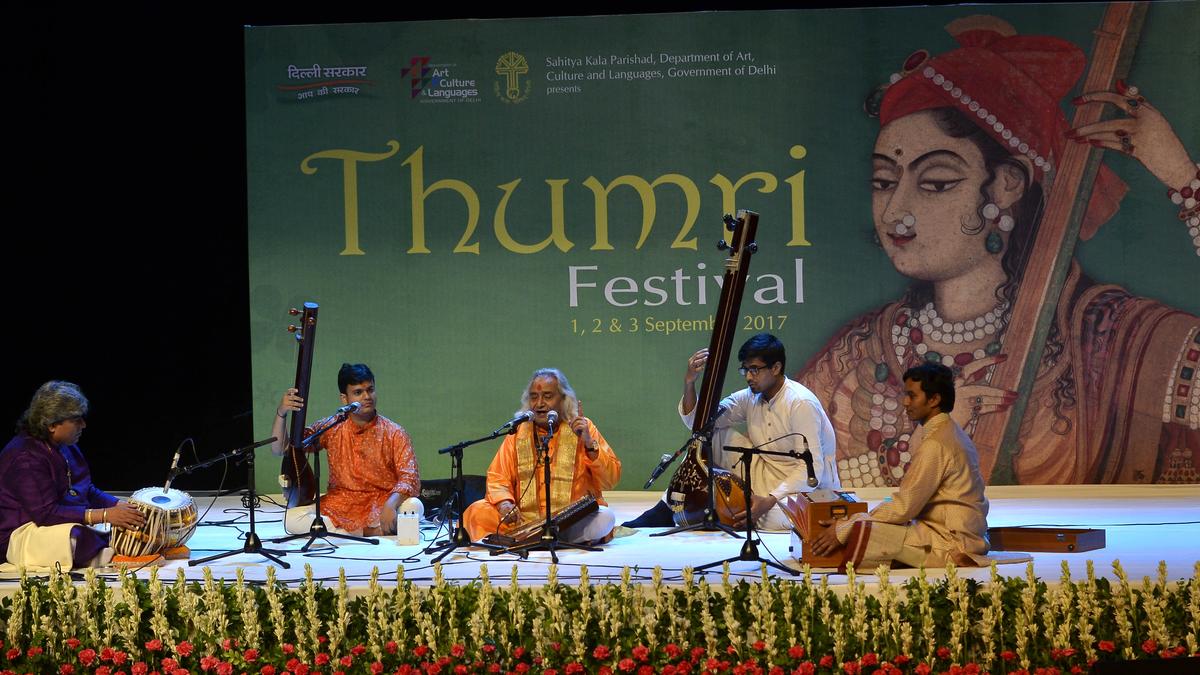
Pt. Chhannulal Mishra classical vocalist, performing at Thumri Festival at Kamani Auditorium in Delhi on September 01, 2017.
| Photo Credit: Shiv Kumar Pushpakar
Thumri fell silent on Thursday (October 2, 2025) as Pandit Chhannulal Mishra, the most mellifluous exponent of the semi-classical art form, passed on due to age-related ailments. Rising from a modest background, Pandit Mishra found his voice on the ghats of Benaras, and his gravelly timbre represented the sacred confluence of the cosmic naad of Lord Shiva’s damru and the serenity of Ganga. The amalgamation of the Kirana and Benaras Gharana would scratch and soothe the soul with its seamless expression of the rigour of Hindustani classical music and the lyrical nuances of semi-classical forms.
Together with Ustad Bismillah Khan, Pandit Mishra represented the syncretic culture of Varanasi, where Lord Shiva and Ganga hold profound musical and cultural significance. He would occasionally dabble in ghazals, integrating their emotive lyricism with ragas like Bhairavi and Kafi.
Also Read | The magic of Pt. Chhannulal Mishra
Spiritually evocative and musically sublime, Mishra’s sensitivity to poetry ensured that every note served the text’s meaning. For the humble Padma Vibhushan, classical music was not a rarefied chamber meant just for the well-heeled. He elevated the taste of the lay listener with his devotional music, which felt both majestic and intimate, exploring themes of mysticism, longing, and cosmic rhythm in Awadhi, Brijbhasha, and Urdu with a sprinkling of Sanskrit sources.
Chhannulal Mishra, Hindustani classical singer, dies at 89
Padma Vibhushan vocalist Pandit Chhannulal Mishra, a towering figure in Hindustani classical music, died early Thursday (October 2, 2025). He was 89.
| Video Credit:
The Hindu
His ability to recite the entire Ramcharitmanas by heart infused his bhajans with scriptural authenticity. From Rama’s poise to Krishna’s mischievous appeal, Pandit Mishra captured the emotional truth of the cultural icons through his singing. From khayal to thumri, chaiti and hori, from Tulsidas to Kabir, his rich devotional repertoire moved from form to formlessness, from the classical to the popular. His silver locks, infectious smile, and the swarmandal as his accompaniment added an ethereal layer to his recitals.
Also Read | Pt. Chhannulal Misha: For the love of thumri
For him, his stage was his temple where he would transform from a scholarly storyteller to an old friend during the course of the recital. Quoting Narada, “I don’t live in heaven nor in the hearts of the Yogis, I live where my devotees sing,” he once explained his relationship with his audience, during a conversation with The Hindu.
Born into a musical family on August 3, 1936, in Hariharpur, eastern Uttar Pradesh’s Azamgarh district, Pandit Mishra was introduced to music by his father, Badri Prasad Mishra. He grew up amidst want, and diverse musical strains enriched his rhythmic sensibility. His grandfather was a distinguished tabla player, Shanta Prasad, and another tabla virtuoso, Pandit Anokhelal Mishra, was his father-in-law. His training under Ustad Abdul Ghani Khan of the Kirana Gharana and exposure to the musical philosophy of musicologist Thakur Jaidev Singh enabled him to transcend the boundaries of gharanas and kahandans and adapt poetry’s nuances into Hindustani classical frameworks. The discerning could appreciate the vigour of the Patiala gharana and the subtlety of the Purab Ang in his singing.
Also Read | Padma Bhushan is too little, too late: Pt. Channulal Mishra
In his 70s, Pandit Mishra found a younger audience when he sang “Saans Albeli” for Shankar-Ehsaan-Loy in Prakash Jha’s Aarakshan (2011). He was truly a musician without reservations, as his renditions continue to travel across generations and tastes.
In 2014, Pandit Mishra emerged as a symbol of cultural nationalism when he became one of the four proposers during Narendra Modi’s nomination as the Bharatiya Janata Party’s (BJP) candidate from Varanasi. A revered figure in the city, his endorsement helped Mr. Modi transcend cultural barriers. The party presented him as the symbol of its agenda of devotion and development. When Mr. Modi emerged victorious, Pandit Mishra rendered Badhaiya (Congratulations) in his unmistakable style at the swearing-in ceremony. On Thursday (October 2, 2025), PM Modi led the outpouring of grief on social media, describing Pandit Mishra as a source of affection and blessings.
He is survived by his son, the gifted tabla player Ram Kumar Mishra, and three daughters.
Published – October 02, 2025 02:51 pm IST























